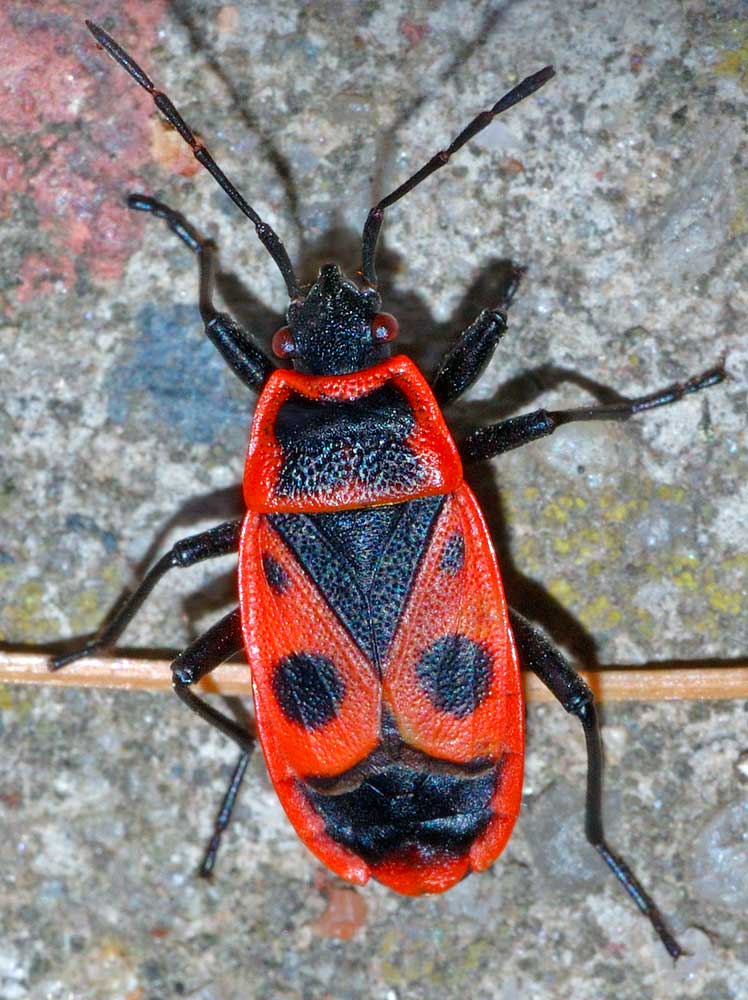
Pyrrhocoris apterus (Photo: André Karwath )
Superregnum: Eukaryota
Cladus: Unikonta
Cladus: Opisthokonta
Cladus: Holozoa
Regnum: Animalia
Subregnum: Eumetazoa
Cladus: Bilateria
Cladus: Nephrozoa
Cladus: Protostomia
Cladus: Ecdysozoa
Cladus: Panarthropoda
Phylum: Arthropoda
Subphylum: Hexapoda
Classis: Insecta
Cladus: Dicondylia
Subclassis: Pterygota
Cladus: Metapterygota
Infraclassis: Neoptera
Cladus: Eumetabola
Cladus: Paraneoptera
Superordo: Condylognatha
Ordo: Hemiptera
Subordo: Heteroptera
Infraordo: Pentatomomorpha
Superfamilia: Pyrrhocoroidea
Familia: Pyrrhocoridae
Genus: Pyrrhocoris
Species: Pyrrhocoris apterus
Name
Pyrrhocoris apterus (Linnaeus, 1758)
Synonyms
Cimex apterus Linnaeus, 1758
References
Primary references
Linnaeus, C. 1758. Systema Naturae per regna tria naturae, secundum classes, ordines, genera, species, cum characteribus, differentiis, synonymis, locis. Editio Decima, Reformata. Tomus I. Holmiæ (Stockholm): impensis direct. Laurentii Salvii. 824 pp. DOI: 10.5962/bhl.title.542 BHL p. 447 BHL Reference page.
Links
Pyrrhocoris apterus Taxon details on Fauna Europaea
ZooBank: F130F35A-AA1C-4FC6-AE62-125E00E6CE01
Vernacular names
العربية: حشرة النار
български: Великденче
čeština: Ruměnice pospolná
dansk: Ildtæge
Deutsch: Gemeine Feuerwanze
English: Firebug
Esperanto: Ruĝa cimo
español: Chinche de la malva arbórea
فارسی: سوسک بالآتشین
suomi: Tulilude
français: Gendarme
עברית: אדמון מצויר
magyar: Verőköltő bodobács
lietuvių: Blakė kareivėlis
Plattdüütsch: Gemeene Füer-Wandluus
Nederlands: Vuurwants
polski: Kowal bezskrzydły
română: Vaca-Domnului
русский: Клоп-солдатик
slovenčina: Cifruša bezkrídla
svenska: Eldlus
українська: Червоноклоп червоний
The firebug, Pyrrhocoris apterus, is a common insect of the family Pyrrhocoridae. Easily recognizable due to its striking red and black coloration, it may be confused with the similarly coloured though unrelated Corizus hyoscyami (cinnamon bug, squash bug) (see comparison).[1] Pyrrhocoris apterus is distributed throughout the Palaearctic from the Atlantic coast of Europe to northwest China. It has also been reported from the US, Central America, and India, and is also found in Australia.[2] It has been reported as recently expanding its distribution northwards into mainland UK and eastward on to the coast of the Mediterranean sea. [3] They are frequently observed to form aggregations, especially as immature forms, containing from tens to perhaps a hundred individuals.
Reproduction
Firebugs generally mate in April and May. Their diet consists primarily of seeds from lime trees and mallows (see below). They can often be found in groups near the base of lime tree trunks, on the sunny side.
They can be seen in tandem formation when mating which can take from 12 hours up to 7 days. The long period of copulating is probably used by the males as a form of ejaculate-guarding under high competition with other males.[4]
Development
P. apterus was the subject of an unexpected discovery in the 1960s when researchers who had for ten years been rearing the bugs in Prague, Czech Republic, attempted to do the same at Harvard University in the United States. After the fifth larval instar, instead of developing into adults, the bugs either entered a sixth instar stage, or became adults with larval characteristics. Some of the sixth instars went on to a seventh instar, but all specimens died without reaching maturity.[5] The source of the problem was eventually proven to be the paper towels used in the rearing process; the effect only happened if the paper towels were made in America. The researchers could replicate these results with American newspapers such as the New York Times, but not European newspapers such as The Times. The cause was found to be hormones found in the native balsam fir tree (Abies balsamea) used to manufacture paper and related products in America, and in some other North American conifers. This hormone happened to have a profound effect on P. apterus, but not on other insect species, showing the diversification of hormone receptors in the insects.[5] The most potent chemical component was later identified as juvabione, the methyl ester of todomatuic acid, which is produced by the trees in response to wounding; it mimics juvenile hormone closely at the chemical level, defending against vulnerable pests.[6][7]
References
Brickfields Country Park: Cinnamon Bug – Corizus hyoscyami
Socha, Radomir (1993). "Pyrrhocoris apterus (Heteroptera)–an experimental model species: a review". European Journal of Entomology. 90: 241–286. ISSN 1210-5759.
Marren, Peter (2010). Bugs Britannica. Chatto & Windus. ISBN 978-0-7011-8180-2.
Schöfl, Gerhard; Michael Taborsky (2004-02-19). "Prolonged tandem formation in firebugs (Pyrrhocoris apterus) serves mate-guarding". Behavioral Ecology and Sociobiology. Springer Berlin / Heidelberg. 52 (5): 426–433. doi:10.1007/s00265-002-0524-9. ISSN 0340-5443. S2CID 19526835.
Karel Slama & Carroll M. Williams (1965). "Juvenile hormone activity for the bug Pyrrhocoris apterus" (PDF). Proceedings of the National Academy of Sciences. 54 (2): 411–414. doi:10.1073/pnas.54.2.411. PMC 219680. PMID 5217430.
W. S. Bowers; H. M. Fales; M. J. Thompson; E. C. Uebel (1966-11-25). "Juvenile Hormone: Identification of an Active Compound from Balsam Fir". Science. 154 (3752): 1020–1021. doi:10.1126/science.154.3752.1020. PMID 5919750. S2CID 19576252.
Jörg Bohlmann; John Crock; Reinhard Jetter & Rodney Croteau (1998-06-09). "Terpenoid-based defenses in conifers: cDNA cloning, characterization, and functional expression of wound-inducible (E)-α-bisabolene synthase from grand fir (Abies grandis)". Proc Natl Acad Sci U S A. 95 (12): 6756–6761. doi:10.1073/pnas.95.12.6756. PMC 22624. PMID 9618485.
Retrieved from "http://en.wikipedia.org/"
All text is available under the terms of the GNU Free Documentation License

